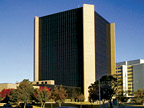The number and diversity of buildings in their charge challenged the city of Wichita and its facilities staff in achieving their goals. Municipal facilities consist of 42 buildings scattered throughout the city and include a 13-story city hall, a convention center, an art museum, police and fire stations, transit and recreation centers, a state office building, and various maintenance facilities. The project would entail retrofitting more than 10,000 fixtures in all 42 buildings and adding building controls at 36 of those sites. The endeavor would also involve coordinating the activities of city personnel, multiple vendors and engineers, and various utility companies. Finally, during implementation, all buildings would need to remain occupied, so citizens could continue to receive city services.

It All Happens From City Hall
Officials turned to Sandifer Engineering of Wichita to develop a plan that would enable the city to achieve its objectives. Sandifer is both an independent contractor and an application-engineering firm for TAC. Sandifer's solution was to link the city's buildings using TAC's I/NET® DDC system.Now, facilities staff can monitor operations from a single workstation located in City Hall. Built upon an open database, I/NET allows users to easily access all system data, link the database with others, and use standard reporting tools. The system includes integrated graphics and enables all sites to automatically report alarms, such as out-of-temperature conditions or equipment failure, to the central workstation. In addition, remote dial-up access is also available for off-site system monitoring.
Some sites, such as the art museum, also maintain local control to ensure a proper environment for exhibits. New enable/disable zone controls in 29 buildings allow existing thermostats to regulate temperatures and to schedule systems operation after hours.
"I/NET Seven provides a flexible, reliable solution for integrated building management, which is exactly what the city of Wichita was looking for," said Bob Sandifer, president of Sandifer Engineering. "Using the system for scheduling temperatures in city buildings has substantially reduced Wichita's energy bills. And because it is designed for large operations, it can easily be expanded as the city grows or its needs change."
In addition to offering centralized and remote system access, and the flexibility to expand the system, the I/NET system features easy-to-follow graphics that illustrate floor plans, direct digital controllers, airflow, and piping. The facilities' staffs use these capabilities for troubleshooting and adjusting ventilation to meet occupant demand.
Free Cooling
Linked by the DDC were other improved systems throughout the city. Sandifer replaced a cooling tower and pumps at the city hall site, installed high-efficiency lighting equipment throughout most of the buildings, and implemented a free cooling retrofit of the convention center's physical plant. According to Sandifer, the addition of the free cooling accessory to the existing 800-ton Trane centrifugal chiller maximizes cooling capacity without running the compressor during cooler weather, providing as much as 40% of chiller design tonnage.Sandifer also applied a hot-deck damper solution to optimize system efficiency by delivering hot air only when and where it is needed. Large AHUs and VSDs minimize air movement to condition a building's environment.
The completed facility improvements cover all 42 buildings and consist of 51 process control units, 16 expansion modules, 29 microregulators, four microcontroller interfaces, and 1,200 control points. With the new DDC and mechanical upgrades, the City of Wichita has achieved a 14% reduction in utility costs, which translates into energy savings of $306,990 annually. Sandifer and TAC delivered a system that provides a controlled, dependable indoor environment and savings that help protect the taxpayers' investment.ES
